#cook:木綿豆腐
Photo

✿ めんつゆレモンソースの豆腐ハンバーグ
#cook:めんつゆレモンソースの豆腐ハンバーグ#cook:木綿豆腐#cook:豆腐#cook:レモン汁#cook:ハンバーグ#cook:ひき肉#cook:合い挽き肉#cook#cook:主菜#cook:2020〜#cook:めんつゆ#cook:味醂×めんつゆ#cook:味醂×めんつゆ×レモン汁#2020〜#cook:味噌#cook:パン粉#cook:たまねぎ#レシピ#レシピ:ハンバーグ
10 notes
·
View notes
Text

Acorn squash soup with teriyaki tofu, udon, and curried apple
This recipe takes notes from squash soup and curry udon to produce an autumnal soup that balances fresh and umami flavors. The bright, crisp tartness of the apples combines with the bite and savor of the tofu and the mildly spiced dashi-based broth to create a fun, playful eating experience in which every bite is different.
Recipe under the cut!
Patreon | Tip jar
Serves 4.
Ingredients:
For the dashi:
3 cups cool water
8g (3" x 4" piece) kombu
For the tofu and teriyaki sauce (照り焼きのたれ):
14oz medium-firm tofu (木綿豆腐 / momen doufu)
1/3 cup potato starch (or substitute cornstarch)
Neutral oil for frying
2 Tbsp sake
2 Tbsp mirin
2 Tbsp Japanese soy sauce, such as Kikkoman's
1 Tbsp + 1 tsp vegetarian granulated sugar
For a low-alcohol version, substitute mirin with aji-mirin (mirin imitation), or half sugar and half dashi; substitute sake with half rice vinegar and half aji-mirin or sugar.
For the soup:
900g (1 large) acorn or kuri squash
1 small yellow onion, chopped
4 cloves garlic, chopped
1-inch chunk (10g) ginger, chopped
1 Tbsp neutral oil
2 servings (400g) fresh uncooked udon (180g dry; 500g frozen)
1 small Granny Smith apple, cored and thickly sliced
2 tsp kare ko (Japanese curry powder), divided
Salt to taste
Sliced green onion and white sesame seeds, to garnish
Instructions:
For the kombu dashi (昆布だし):
1. Check kombu for mold and wipe off any visible dirt with a damp towel, leaving the white residue. Make a few slits on the edges of the kombu with a pair of kitchen scissors to aid the release of flavor. Decide which kind of dashi to make based on how much time you have.
2. To make cold-brew (水出し / mizudashi) dashi: Soak the kombu in 3 cups of cool water in a covered pot or large bottle in the refrigerator overnight. Remove the kombu and strain; the dashi is ready to use.
3. To make hot-brew dashi (煮出し / nidashi): Optionally, soak the kombu in 3 cups of cool water in a covered pot for 2 hours in a hot environment or up to 5 hours in a cold one. Uncover the pot, place it over medium heat, and allow the water to slowly come to a boil, occasionally skimming the scum from the top of the water with a skimmer or a spoon. Just as the water begins to simmer, remove the kombu and take the pot off heat (the dashi may become slimy and bitter if the kombu is boiled). Strain the dashi; it is ready to use.
Reserve kombu to brew again and make second dashi (二番だし / niban dashi), to simmer with vegetables to make a simmered dish (煮物 / nimono), or to make furikake. It can be sealed in a plastic bag and saved in the fridge for about a week, or in the freezer for several months.
1. Drain tofu, wrap it gently in a kitchen towel, and allow it to sit for about 10 minutes to release water (there is no need to press it).
2. Cut tofu into 1" (2.5cm) cubes and gently toss them in potato or cornstarch (potato starch will yield a crunchier result).
3. Heat about 1/2" (1 cm) of oil in a large pan. Fry tofu, flipping as necessary, until golden brown on all sides. Set aside. (Note that tofu will stick to the bottom just at first; it will release as the starch cooks.)
4. In a large pan (the same one you used to fry the tofu is fine, if you remove the oil), combine tofu, sake, mirin, soy sauce, and sugar. Cook, stirring constantly, until the sauce has thickened to coat the tofu. Be careful not to allow the sugar to burn. Set aside.
For the soup:
1. Prepare the vegetables. Halve the squash lengthwise (through the root) and scoop out the seeds. Peel it with a vegetable peeler or paring knife and cut it into cubes. Peel and chop the onion, garlic, and ginger.
2. Heat oil on medium-high in a large pot until spluttering. Add onions and a pinch of salt and fry, stirring frequently, until softened and translucent. Add garlic and ginger and fry for another minute, until no longer raw-smelling.
3. Add 1/2 tsp curry powder and stir to combine. Add the cubed squash and sauté, stirring occasionally, for a few minutes.
4. Add dashi and another 1/2 tsp curry powder. Cover and raise heat to high to bring to a boil. Reduce to a low simmer and cook for aboute 15 minutes, until squash is very tender.
5. Remove from heat and allow to cool slightly. Blend contents of the pot with an immersion blender, or in a blender or food processor, until liquid and even in texture. Cover.
For the udon:
1. Bring a large pot of unsalted water to a rolling boil. Shake excess starch off of the noodles and add them to the pot.
2. Cook, stirring occasionally with chopsticks or a pasta spoon, until the noodles are cooked through and no longer taste raw. This will take 10-13 minutes for fresh or dried noodles, and 13-15 minutes for frozen. If your frozen noodles are parboiled, they will only need to be blanched for 30 seconds to a minute: be sure to read the package instructions.
The noodles should be slippery and neither hard in the center (if dried) or mushy on the outside, but firm and “koshi” (こし or コシ; “with body,” “al dente”).
3. Drain and rinse with cold water to halt cooking and rinse off excess starch. Set aside.
For the tofu:
1. Drain tofu, wrap it gently in a kitchen towel, and allow it to sit for about 10 minutes to release water (there is no need to press it).
2. Cut tofu into 1" (2.5cm) cubes and gently toss them in potato or cornstarch (potato starch will yield a crunchier result).
3. Heat about 1/2" (1 cm) of oil in a large pan. Fry tofu, flipping as necessary, until golden brown on all sides. Set aside. (Note that tofu will stick to the bottom just at first; it will release as the starch cooks.)
4. In a large pan (the same one you used to fry the tofu is fine, if you remove the oil), combine tofu, sake, mirin, soy sauce, and sugar. Cook, stirring constantly, until the sauce has thickened to coat the tofu. Be careful not to allow the sugar to burn. Set aside.
For the apples:
1. Wash and cut apples into slices about 1/2" (1 cm) thick. Coat them in the remaining curry powder.
2. Heat margarine in a large pan on medium until melted and sizzling. Reduce heat to low and add apple slices in a single layer. Fry, flipping once, until slightly softened and browned on both sides. You still want a bit of bite to them!
To assemble:
1. Reheat the broth on the stovetop. Submerge the noodles in a pot of hot water for about 30 seconds to warm. Divide noodles into individual serving bowls and cover with broth, apples, tofu, sliced green onion, and sesame seeds.
#vegan cooking#recipes#vegetarian recipes#Japanese#American#fusion#squash#acorn squash#kuri sqash#udon#soups#apple#tofu
82 notes
·
View notes
Photo
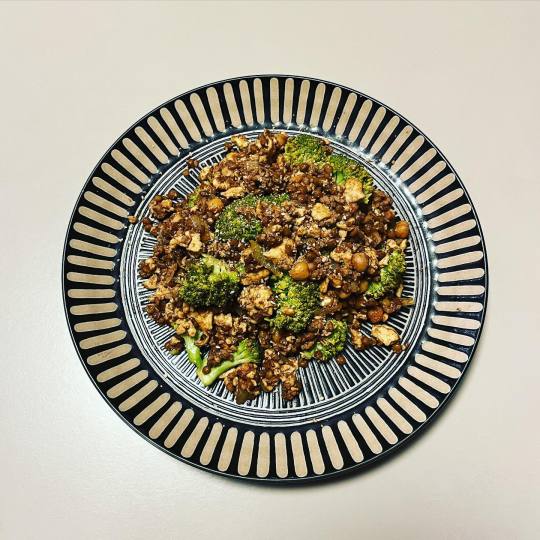
#ひき肉 #玉ねぎ #ガルバンゾー #ひよこ豆 #レンズ豆 #木綿豆腐 #ブロッコリー #カレー粉 #オイスターソース #すりごま * #まゆげごはん #MAYUGEgohan #おうちごはん #ふたりごはん #うちメシ #自炊 #男の料理 #料理男子 #男飯 #料理おじさん #food #instafood #foodstagram #cookingman #cooking #selfcook #EatAtHome #カマ飯 #gaycook https://instagr.am/p/CeOrRyXvLHR/
0 notes
Photo

Cooking is also creativity. 『レゴから見える食卓』 『すき焼き弁当』 こちらは黒毛和牛のロース肉を使った、すき焼き弁当です。 すき焼きと言えば、 肉に醤油と砂糖の甘辛の味を バランスよく付け、 甘みと塩加減が調和した日本ならではの肉料理です。 すき焼きは、元は関西地方で 親しまれていた呼び名で、関東地方では牛鍋と呼ばれていたとか。 明治時代に入るまで、 公的に肉食が禁じられていたようですが、 猪や鹿などのジビエ料理を食していたという話もあります。 すき焼きと言うクラシックな料理ですが、伝統的な調理方法、具材は活かしつつ、現代風にアレンジしました。 レゴのヒストリーでは、「It has come a long way over the past almost 90 years - from a small carpenter’s workshop to a modern, global enterprise that is now one of the world’s largest manufacturers of toys.」 とあり、 これはレゴが小さな工房から生まれ、 90年近い道のりの中で、 今では世界最大クラスの 玩具メーカーの1つにまで成長し、 現代のグローバル企業になったということです。 すき焼きと言う料理の語源は、 元はすき焼き用の鍋ではなく、 代わりに農具の鋤(すき)の 金属部分を使い、 その鋤を火の上にかけて熱し、 鋤を使って魚や豆腐を 焼いて食べたことが、 鋤で焼く、鋤焼(スキヤキ)と 呼ばれるようになったそうです。 おそらく、 すき焼きの元になった料理が 出来始めた頃、 今のように一般的に普及し、 長く親しまれるような料理に なっているとは想像できなかったのではないでしょうか。 今回作ったのは、 黒毛和牛のロース肉を使った、 すき焼き弁当で、 メインのお肉に加え、 国産白ネギ、国産舞茸、 国産大豆の木綿で自家製焼き豆腐、花にんじん、 糸コンニャク、春菊などの具材を入れています。 中心となる黒毛和牛のインパクトはもちろんですが、 このお肉が引き立つためには、 ネギやキノコ、豆腐やコンニャク、飾りニンジンなどの 脇役が欠かせないのです。 名作の陰にはバイプレーヤーがいるということが重要ですが、 主役となる牛肉が魅力的だからこそ、 脇をかためる野菜や豆腐などの具材にも気を配りたいものです。 ※レゴは神戸三田プレミアムアウトレット店で購入したものとを @photobusuki が撮影しております。 料理は我が家の普段の食卓。 料理研究家 指宿さゆり 写真家 指宿慎一郎 @photobusuki ーーーーーーーーーーー #料理研究家指宿さゆり #レシピ開発 #レシピ制作 #レシピ制作専門スタジオ #料理は教養 #食は品性 #料理好き #創造力が世界を変える #lego #レゴシティ #レゴミニフィグ #ゆとりある暮らし #インスタ映え #legostore #フォトジェニック #すき焼き弁当 #すき焼き #アスリート飯 #おうち定食 #レゴ好き #こどものいる暮らし #レゴから見える食卓 #神戸料理教室 #神戸三田プレミアムアウトレット #教育 #食育 #お子様ランチ #レゴブロック #レゴ #こどもごはん (レゴクリックブリック神戸三田店) https://www.instagram.com/p/CeBC4m5v866/?igshid=NGJjMDIxMWI=
#料理研究家指宿さゆり#レシピ開発#レシピ制作#レシピ制作専門スタジオ#料理は教養#食は品性#料理好き#創造力が世界を変える#lego#レゴシティ#レゴミニフィグ#ゆとりある暮らし#インスタ映え#legostore#フォトジェニック#すき焼き弁当#すき焼き#アスリート飯#おうち定食#レゴ好き#こどものいる暮らし#レゴから見える食卓#神戸料理教室#神戸三田プレミアムアウトレット#教育#食育#お子様ランチ#レゴブロック#レゴ#こどもごはん
0 notes
Photo


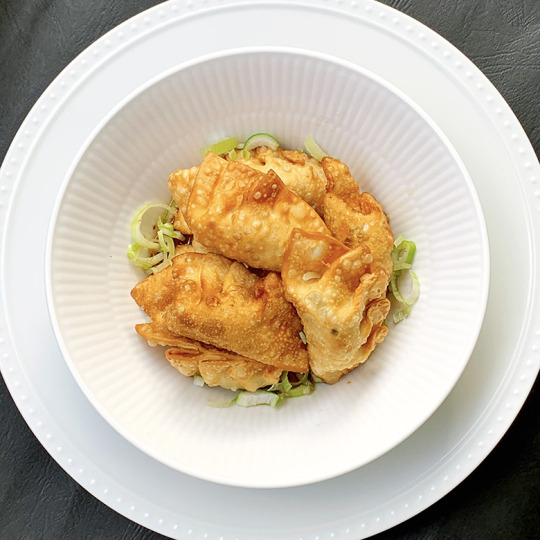
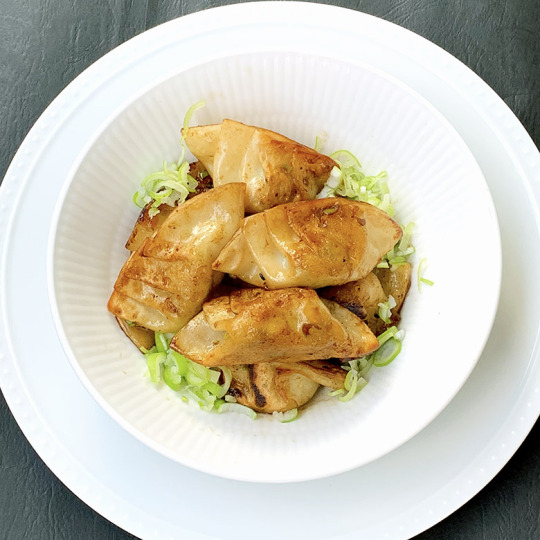


レシピ
2020年02月
料理レシピ
…
絹豆腐と木綿豆腐餃子のスープ
…
今回は鶏ひき肉でスープを取って、具を絹豆腐と木綿豆腐・おからパウダー・豚ひき肉・エビ・玉ねぎ・にんにくの芽等で餃子を。 …
つるんといただける豆腐餃子スープです。 …
豆腐餃子スープに溶き卵を入れた卵スープなども作ってみました。
…
豆腐餃子レシピで、作ることができた餃子各種。(上記写真参照)
1.スープ餃子・・・餃子10個(卵スープも含む)
2.揚げ餃子・・・・餃子15個
3.焼き餃子・・・・餃子15個
4.豆腐ハンバーグ・・・ハンバーグ3個
…
今回のレシピ材料で、餃子40個、ハンバーグ3個作ることができます。
.
…
*焼き餃子は、最後にごま油・ポン酢・七味で味付けしています。
…
*ハンバーグは、最後にポン酢をひとかけして焼いています。
…
*スープに使用した鶏ミンチは、味噌・酒・みりん・砂糖・七味・バターでそぼろにしました。
…
お好みに合わせてお作りいただけたらと思います。
…
今回もヘルシーレシピで、はんなりお楽しみください。
…
…
…
…▶︎レシピページは、プロフィールのリンク
………f-cpc.jp から
…
…
…絹豆腐と木綿豆腐餃子のスープ
のレシピページ
https://f-cpc.jp/kaiseki-01/2020-02/03-rep
…
…
…
…材 料
.
《 スープ 》
水だし ・ 7・1/2C
酒 ・ 大2
塩 ・ 小1
生姜(薄切り) ・ 1枚
長ネギ ・ 5cm
鶏ミンチ ・ 300g
干しシイタケ ・ 2枚
.
.
絹豆腐 ・ 1丁
ネギ
.
.
.
《 木綿豆腐餃子 》
海老(正味) ・ 80g
塩
片栗粉
.
.
木綿豆腐 ・ 1丁
おからパウダー ・ 20g
豚ミンチ ・ 150g
干しシイタケ ・ 4枚
にんにくの芽 ・ 80g
長ネギ(みじん切り) ・ 適量
生姜(みじん切り) ・ 1/2個
にんにく(みじん切り) ・ 1かけ
塩 ・ 小1
酒 ・ 小1
ごま油 ・ 小1
餃子の皮 ・ 40枚
…
…
…
…作 り 方
.
《 下準備 》
1.干しシイタケを水につけて戻しておきます。(戻し汁はスープに使うので取っておきます。)
.
.
.
《 スープ 》
1.鍋にスープの材料を入れて、強火にかけます。
.
2.沸騰したら火を弱めてアクを取ります。
.
3.そのまま20〜30分煮たらざるにキッチンペーパーを敷いて、とったダシをこします。
.
4.鍋にこしただし・干しシイタケの戻し汁を入れて、干しシイタケの石づきを切り落して薄切りにした干しシイタケ、絹豆腐を手て崩して入れ沸騰させておきます。
.
.
《 木綿豆腐餃子 》
1.エビの殻をとり、エビの背中にそって包丁を入れて背ワタを取ります。エビを1cmのぶつ切りにして、片栗粉・塩を入れて粘りが出るまでもみ、汚れが浮いてきたら流水でよく洗い流して水気をキッチンペーパーで取っておきます。
.
2.おからパウダーに木綿豆腐を混ぜておきます。
.
3.(2)に豚ミンチ・干しシイタケのみじん切り・にんにくの芽のみじん切り・長ネギ(みじん切り)・生姜(みじん切り)・にんにく(みじん切り)・塩・酒・ごま油を入れてよく混ざ合わせます。
.
4.皮に(3)のたねをのせてまわりに水をつけて包みます。
.
.
《 絹豆腐と木綿豆腐餃子のスープ 》
1.木綿豆腐餃子をたっぷりの熱湯で手早く茹で、熱くしたスープの鍋の中に入れてしっかり火が通るまで煮込みます。
.
2.器に(1)を入れて、刻みネギ等を浮かべたら出来上がりです。
…
…
…
…follow@cpc_cooking…
…
…
#うまい #美味い #うまし #旨い
#美味しそう #おいしいもの
#デリシャス #食スタグラム #food
#foodphotography #にんにく
#ニンニク #recipe #recipes
#cooking #cookingram
#豆腐レシピ #豆腐 #豆腐料理
#絹豆腐 #木綿豆腐
#餃子 #餃子好き #餃子作り
#餃子スープ #豆腐スープ
#焼き餃子 #揚げ餃子
#卵スープ #豆腐ハンバーグ
4 notes
·
View notes
Photo

ミョウガたっぷり冷や奴 木綿豆腐を水切り、フライドオニオンに茗荷の千切り、黒胡椒を挽いてオリーブオイル。食べる直前にだし醤油。 オリーブオイルはフルーティなものを使ったので茗荷の香りと合わなかった。もう少し青い香りのするオリーブの品種で作ったオイルを使った方がよかったかな。反省。味は豆腐なのでほどほどに美味しい。 #冷や奴#豆腐#tofu#茗荷#ミョウガ#みょうが#黒胡椒#blackpepper#soysauce#醤油#料理#おうちごはん#cooking #food#foodie#foodies#foodgasm#foodgram#foodphotography #foodporn#delicious#yummy#yum#tasty#gastronomy https://www.instagram.com/p/By-f1eXgN08/?igshid=19ftz2cy23o70
#冷や奴#豆腐#tofu#茗荷#ミョウガ#みょうが#黒胡椒#blackpepper#soysauce#醤油#料理#おうちごはん#cooking#food#foodie#foodies#foodgasm#foodgram#foodphotography#foodporn#delicious#yummy#yum#tasty#gastronomy
1 note
·
View note
Text
Appendix: the Rikyū Hyakkai Ki, Part 32: (1591) Intercalated First Month, Thirteenth Day, Evening.
92) Intercalated First Month, Thirteenth Day; Evening¹.
○ Uraku sama [有樂樣]², Ryūami [立阿彌]³.
○ 4.5-mat [room]⁴.
○ Hairyō gama [拜領釜]⁵;
◦ seitaka chawan [せい高茶碗]⁶;
◦ chaire ・ Konoha-zaru [茶入・木の葉ざる]⁷;
◦ Seto mizusashi [瀬戸水さし]⁸;
◦ usucha ・ Tenka-ichi [うす茶・天下一]⁹;
◦ hirai Seto mizu-koboshi [平イせと水こぼし]¹⁰.
○ Koi no yaki-mono [鯉ノやき物]¹¹;
◦ konowata [このわた]¹²;
◦ koma-koma jiru [こまゝゝ汁]¹³;
◦ meshi [めし]¹⁴.
○ Hikite [引て]:
◦ dengaku [でんがく]¹⁵.
○ Kashi [菓子]:
◦ fu-no-yaki [ふのやき]¹⁶;
◦ yaki-guri [やきくり]¹⁷.
_________________________
¹Urū-shōgatsu jūsan-nichi ・ ban [閏正月十三日・晩].
The Gregorian date of this chakai was March 8, 1591.
An evening chakai generally began shortly after sunset (so that the guests could come to the host’s house without the inconvenience of needing to light their way with a lantern), so the sky would have still been reasonably bright when the guests first entered the room for the sho-za. Thus auxiliary lighting was usually kept to a minimum* at this time. It would be quite dark when they went out for the naka-dachi, however, and so the artificial light had to be increased starting around the time that the kaiseki was served†.
__________
*Generally a paper-shrouded oil lamp sufficed to welcome the guests at the beginning of the sho-za.
†Usually by bringing out a paper-shrouded candlestick to illuminate the shōkyaku's zen.
The flames in the stone lanterns in the roji were lit as the sho-za came to an end, and an andon [行燈] was placed in the genkan near the guests' entrance so they could light their way through the roji to the koshi-kake for the naka-dachi. On their return, the paper shades would have all been removed from the oil lamp and candle that gave light to the interior of the tearoom.
²Uraku sama [有樂樣].
This was the daimyō-nobleman Oda Nagamasu [���田長益; 1547 ~ 1621], a younger brother of Oda Nobunaga. He originally served as an Imperial Chamberlain (jijū [侍従], for which he received the junior grade of the Fourth Rank). He converted to Christianity (taking the name of John) in 1588, and was known as Urakusai [有樂齋] after he retired from public life in 1590.
Urakusai was also a chajin, and had been a close personal friend of Rikyū’s since when Nobunaga was alive. He was also one of the few people whom Hideyoshi treated with perpetual deference.
³Ryūami [立阿彌].
This refers to the man known as Ise-ya ・ Ryūami [伊勢屋・立阿彌], who was a machi-shū chajin from Kyōto.
A letter written to him by Rikyū dated the Thirteenth Day of the Fourth Month suggests that he also held an official position at Juraku-tei – perhaps as one of Hideyoshi’s sadō [茶頭]. Thus he was also an individual who might have private access to Hideyoshi, at least occasionally.
Ryūami’s name is found in a number of other documents from this period, such as the Tennōji-ya Kai Ki [天王寺屋會記] and Tsuda Sōkyū’s diary of his own gatherings (the Tsuda Sōkyū Ji-kaiki [津田宗及自會記]), showing that he was indeed a serious practitioner of chanoyu. He also appeared as a guest at another of Rikyū’s gatherings (that is described in the Rikyū Hyakkai Ki), in the morning of the 20th day of the Eleventh Month of Tenshō 18.
⁴Yojō-han [四疊半].

⁵Hairyō gama [拜領釜].

This small kama (which had originally been made as a kiri-kake gama for use on a large teteu-buro) was suspended over the ro on a bamboo jizai (shown below in an Edo period sketch),

using Rikyū's bronze kan [鐶] and tsuru [弦].

⁶Seitaka chawan [せい高茶碗].

This is the same kuro-chawan that Rikyū received from Chōjirō at the end of the previous year.
⁷Chaire ・ Konoha-zaru [茶入・木の葉ざる].

While this karamono nasu-chaire [唐物茄子茶入] is usually depicted resting on a karamono tsui-koku chaire-bon [唐物堆黒茶入盆] today, the tray was not paired with this chaire until the Edo period, and so has nothing to do with Rikyū’s tastes or preferred usage (though the opposite is generally implied in the presentations). Rikyū, in fact, used this chaire without a tray, with the chashaku resting on the lid as usual.

He thus would also have used an ordinary ori-tame [折撓] with this chaire (though the chashaku is not mentioned in the kaiki), one that he had made by himself.
⁸Seto mizusashi [瀬戸水さし].

⁹Usucha ・ Tenka-ichi [うす茶・天下一].

Tenka-ichi [天下一] refers to Hideyoshi's lacquer artist Tenka-ichi ・ Seiami [天下一・盛阿彌].
This lacquered nakatsugi seems to have been an exact copy of the original shin-nakatsugi that was used by Shukō, hence Rikyū's esteem.
Serving usucha in a separate temae* was not Rikyū’s usual way of doing things, and he probably did so on this occasion as a way to encourage the guests to linger and discuss something -- something very important or perhaps urgent -- as night deepened†.
___________
*When Rikyū served usucha during the same temae -- what is now known as tsuzuki-usucha [續き薄茶] -- he always did so using the tea remaining in the chaire from the service of koicha. Preparing a separate container of matcha for usucha meant that this tea was served during a separate temae.
†Given the timing of this chakai -- the gathering that Rikyū hosted for Tokugawa Ieyasu (at which he was supposed to poison Ieyasu on Hideyoshi’s orders) -- was only 10 days away, Rikyū was probably looking for moral support (if not advice) from two men who were trustworthy friends. That Rikyū, of course, did not murder Ieyasu, implies that he was looking for some way to get out of the order (rather than looking for the resolve necessary to do the deed).
¹⁰Hirai Seto mizu-koboshi [平イせと水こぼし].
This entry seems to contain an error, probably the result of Rikyū's dyslexia*.
This would have actually been the same Shigaraki kame-no-futa koboshi that Rikyū had been using in recent days.

In addition to which he would have used an ordinary take-wa [竹輪] as his futaoki, as usual.

___________
*Rikyū usually wrote the individual entries his kaiki in a very specific order, as his sort of dyslexia seems to incorporate ritualized behavior as a sort of comfort device:
◦ the room,
◦ kama,
◦ mizusashi,
◦ chawan,
◦ chaire,
◦ chashaku,
◦ futaoki,
◦ koboshi,
◦ cha-tsubo, and,
◦ kakemono or hanaire.
The fact that, on this occasion, he seems to have forgotten the mizusashi, and then added it later, implies that he was extremely stressed. Writing Seto (the kamamoto where the mizusashi had been made) rather than Shigaraki, could be another manifestation of his condition, and might provide insights into his deteriorating mental state at this time.
As the plans for Hideyoshi's invasion of the continent (which Rikyū seems to have strongly opposed) began to assume their final form -- and as Hideyoshi was now demanding that Rikyū assassinate Tokugawa Ieyasu (during a chakai, no less) -- Rikyū was becoming increasingly agitated, and his frustrated impotence to do anything that could counter Hideyoshi’s will (and still preserve his life) in the face of these pending crises is beginning to show.
It is possible that the next entry in this translation of the kaiki (which, as the first of the record of the kaiseki, would have been entered into the kaiki during the chakai itself, or immediately thereafter) also contains a similar sort of solecism.
¹¹Koi no yaki-mono [鯉ノやき物].
Koi no yaki-mono [鯉の焼物] means charcoal-grilled carp.
While it is possible to grill carp, this generally was not done*. Thus, while Rikyū wrote koi, it is possible that he actually served sea bream (tai [鯛]), a fish much more suitable for preparation in this way. Perhaps this entry represents another dyslectic mistake on Rikyū’s part.
__________
*This is because of the small bones that the flesh contains. When carp is prepared as sashimi, it is possible to carve the fillets to remove the bones. But grilling requires a thicker portion of the fillet with the skin intact, and the bones (which can not be extracted) makes this style of preparation difficult (and potentially dangerous -- especially at night, when the guest would be even less likely to be able to spot the bones).
¹²Konowata [このわた].
The salted entrails (mainly the gonads and their contents) of the sea cucumber.
¹³Koma-koma jiru [こまゝゝ汁].
This seems to be what is now known as atsume-jiru [集め汁], a version of miso-shiru in which vegetables (daikon, gobō, bamboo shoots, taro petioles known as zuiki [芋茎], and other vegetables that remain fairly crisp after cooking), momen-tōfu, and things like dried fish (including kushi-awabi), are served in a stew-like mixture.
This kind of dish would provide a more substantial offering than just miso-shiru, and Rikyū likely chose it because a gathering held at this time of day included the evening meal.
According to the Hisada-bon [久田本] version of the Rikyū Hyakkai Ki, ko-tori [小鳥]* were added to the soup (rather than something like dried fish).
__________
*Ko-tori [小鳥] is a generic name that refers to the various sparrows and finches that were often taken by the hawkers.
The cleaned birds were probably chopped up into small pieces (with at least the larger bones removed) and then boiled before being added to the miso-shiru.
¹⁴Meshi [めし].
Steamed rice.
¹⁵Dengaku [でんがく].
Dengaku [田樂] is a general name for a cooking style in which grilled food is painted with a miso-based glaze* while it is cooking. This was originally a folk dish that had only recently been adopted by the upper classes. Dengaku, then, would have been an interesting and quite novel dish to serve as the hiki-mono.
Rikyū does not say precisely what sort of food was used, but pieces of momen-tōfu [木綿豆腐] threaded onto bamboo skewers seems a likely candidate, since the same tōfu would also have been included in the miso-shiru that was served earlier.
__________
*A mixture of miso (white or red, or a blend of both, according to preference and the food that is being cooked), sugar, mirin, and sake [酒]: traditionally roughly one part each of sake, mirin, and sugar are combined with two parts of miso to make the dengaku glaze (though the amount of sugar may be increased or decreased to taste -- in Rikyū’s day blocks of sugar resembling tallow were imported from China, and so this commodity was both costly and rare, and consequently used sparingly: if a sweeter taste was preferred, one used freshly made white miso, which is naturally sweet, though it begins to loose its sweetness several days after being made).
The pasty glaze is painted onto the upper side, and the tōfu is not turned over until after the paste has dried (so that it will not drip off). It is cooked for a short time with the glazed side facing the fire, until the sugar in the miso-glaze begins to caramelize, and should be served immediately after while it is still hot.
¹⁶Fu-no-yaki [ふのやき].
Rikyū's wheaten crêpes, spread with sweet white miso or miso-an, and then rolled or folded into bite-sized pieces.
¹⁷Yaki-guri [やきくり].
Roasted chestnuts.
4 notes
·
View notes
Photo

太子食品工業株式会社から 『一丁寄せ生とうふ』の絹・木綿豆腐を頂きました。 * 原料にこだわり、 甘みとイソフラボンの多い大豆を厳選し、豆の美味しさを最大限引き出した豆乳から作られ、 保存水がなく、熱殺菌していないので、甘み・旨みが、そのまま味わえるおいしさ。 * 太子食品のお豆腐は、時々買っていますが、絹ばかりでしたが、木綿があまりにも美味しくて新たな発見でした😍 * 私が料理を担当する時は、サクッと作れるものばかりです💦 材料さえあれば、簡単に作れるので、レシピは、ブログに載せますね。 * 木綿豆腐を凍らせて解凍して調理するとお肉のような食感になってヘルシー✨ 粗く潰して味噌を溶いて冷スープにしたり、炒めてゴーヤチャンプルにしたり、 和食だけじゃなく、洋風料理にも豆腐は合います。 豆腐を焼いてチーズを乗せて蒸し焼きにしたり、 いろんなアレンジ料理に使えるのが豆腐です。 しかも、ボリューム満点何で、豆腐一丁あれば、満足感の高いお料理が作れます。 * #太子食品 #一丁寄せ生とうふ #タイシ食品 #PR #豆腐 #豆腐メニュー #時短レシピ #イソフラボン #生とうふ #生 #おうちごはん #tofu #healthy #yummy #japanesefood #藤本祐子グルメ写真 #cooking #創作料理 @yuko_fuji3 ← #followalways 💕 (Stay Home) https://www.instagram.com/p/CEE1fGVAX5O/?igshid=w65wx8thfgha
#太子食品#一丁寄せ生とうふ#タイシ食品#pr#豆腐#豆腐メニュー#時短レシピ#イソフラボン#生とうふ#生#おうちごはん#tofu#healthy#yummy#japanesefood#藤本祐子グルメ写真#cooking#創作料理#followalways
0 notes
Text
Tofu Salad with Sesame Ponzu Dressing 豆腐サラダ
This easy Japanese Tofu Salad with Sesame Ponzu Dressing is a refreshing salad with leafy greens, tofu, corn, wakame seaweed, and fragrant Japanese herb – shiso leaves. You’ll love the tangy ponzu sauce too. It is super easy to make and goes well with many Japanese and Asian dishes. So make a big batch!
When I make Japanese style meal, I try to plan out the meal by following the Japanese Ichiju Sansai – “One Soup Three Dishes” rule, which involves one main dish, 2 sides, steamed rice, miso soup, and pickles.
On a busy day (most weeknights, frankly speaking), I don’t have time to prepare two kinds of side dishes, so one of them tend to be an easy salad that I can put together in no time. This Tofu Salad with Sesame Ponzu Dressing (豆腐サラダ) is my go-to salad recipe for over decades and it’s always my family’s favorite.
Refreshing Chilled Tofu Salad with Sesame Ponzu Dressing
Many of you have asked me if we can eat the tofu without cooking it. And the answer is yes, you can eat the tofu out of the package which is sold in the grocery store’s refrigerated section.
In the summer months, we eat Hiyayakko, which is a cold tofu as an appetizer or side dish.
Tofu salad is sort of an extension of Hiyayakko, served with leafy lettuce and other colorful ingredients. With soy sauce, ponzu, sesame oil, and sesame seeds, the dressing goes well with any Japanese-style meal or other Asian dishes.
Key Ingredients for Tofu Salad with Sesame Ponzu Dressing
1. Ponzu
Ponzu (ポン酢) is a citrus-based soy sauce packed with umami from kombu and katsuobushi (dried bonito flakes) and tanginess from citrus fruits. If you love ponzu, I would suggest making your own Homemade Ponzu following my recipe. It’s super easy and delicious, and you will not buy a bottle of ponzu from grocery stores anymore.
The acidic portion of this dressing comes from the citrus ingredients to make ponzu. If you decide not to use ponzu in this recipe, make sure to add rice vinegar or other citrus fruits to compromise the acidic part.
2. Soft/Silken Tofu
Sometimes having too many choices can be a bit confusing, such as variations of tofu. Different tofu brands offer different level of softness, but in general, we have Kinugoshi Tofu (絹漉し豆腐; “silk-filtered tofu”) and Momen Tofu (木綿豆腐) in Japan. Typically for tofu salad, we use silken tofu as the texture is smooth and soft.
3. Sesame Oil
For this salad dressing recipe, I use sesame oil instead of vegetable oil. Sesame oil has a nice fragrance and it is known for its effect to trigger one’s appetite. If you don’t have sesame oil, use neutral flavored oil such as vegetable oil (for example, olive oil is not considered “neutral flavor”).
4. Yuzu Kosho (optional)
Yuzu Kosho (柚子胡椒) is a paste made from chili peppers, yuzu peel, and salt which is then allowed to be fermented. It’s a wonderful condiment that I highly recommend searching for when you visit a Japanese grocery store. I LOOOOVE to add a bit of this paste in my miso soup.
Adding just a touch of yuzu kosho paste in the dressing adds some spicy and umami kick. There is nothing like this condiment. You can get this brand of yuzu kosho on Amazon (I’ve never tried it, so I can’t say much about the quality). If you did decide to buy it, let me know what you think.
5. Shiso Leaves (optional)
This Japanese herb is one of my favorites and it’s worth growing in your own garden if you can’t find it in your local Japanese grocery store (you can find the seeds from Kitazawa Seed Company).
There is no good substitute for it in terms of flavors – the closest would be Korean/Vietnamese perilla leaves. Shiso leaves give pleasant fragrance and flavors to the salad. If you can find them in your Japanese grocery store, you must grab them to add to this salad.
Variations for Tofu Salad + Sesame Ponzu Dressing
Tofu is the star of this salad, but if you are not a big fan of tofu, there are other ingredients you can choose which go well with Sesame Ponzu Dressing.
steamed shredded chicken
deep fried tofu
boiled shrimp
shabu shabu thinly sliced pork
boiled egg
What else would you like to add? If you tried this recipe and have some good suggestions, let us know!
Don’t want to miss a recipe? Sign up for the FREE Just One Cookbook newsletter delivered to your inbox! And stay in touch on Facebook, Pinterest, and Instagram for all the latest updates.
Tofu Salad with Sesame Ponzu Dressing
½-1 red leaf lettuce ((rinsed and pat dry))
½ block silken tofu ((drained))
1 Tbsp dried wakame seaweed
¼ cup corn kernels ((optional))
8 grape tomatoes ((halved, optional))
5 Shiso leaves (Ooba) ((optional))
Dressing
3 Tbsp Ponzu
1 Tbsp soy sauce
1 Tbsp sesame oil
⅛ tsp Kosher salt
½ Tbsp white sesame seeds (roasted/toasted)
⅛ tsp Yuzu Kosho (optional and more for spicy taste)
Gather all the ingredients.
Put dried wakame seaweed in water to rehydrate for 10 minutes. Once wakame is soft and tender, squeeze water out and set aside.
In a small bowl, combine 3 Tbsp Ponzu, 1 Tbsp soy sauce, 1 Tbsp sesame oil, and ⅛ tsp Kosher salt.
Add ½ Tbsp white sesame seeds and ⅛ tsp Yuzu Kosho (optional and more for spicy taste). Whisk all together.
Stack shiso leaves and cut into julienned strips.
Cut the tofu into small cubes.
Cut the lettuce into bite size pieces and place on the serving platter. Top with corn kernels and cherry tomatoes.
Place the tofu, wakame seaweed, and shiso leaves.
When ready to serve, drizzle the dressings and put some remaining on the small cup/bowl.
Recipe by Namiko Chen of Just One Cookbook. All images and content on this site are copyright protected. Please do not use my images without my permission. If you’d like to share this recipe on your site, please re-write the recipe and link to this post as the original source. Thank you.
Editor’s Note: The post was originally published on January 20, 2011. New images have been added and the content has been updated in July, 2018.
The post Tofu Salad with Sesame Ponzu Dressing 豆腐サラダ appeared first on Just One Cookbook.
Tofu Salad with Sesame Ponzu Dressing 豆腐サラダ published first on https://zenramensushi.tumblr.com/
0 notes
Photo
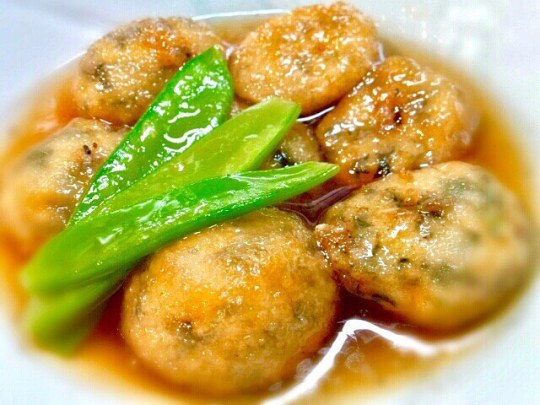
No328 白あえホウレン草の揚げ出汁?豆腐とホウレン草の明石焼き風出汁煮? ー ●材料 ホウレン草 木綿豆腐 鶏胸挽き肉 さやえんどう 生姜 片栗粉 めんつ�� 鰹だし 酒 味醂 酢 塩 サラダ油 ー ●塩加えたお湯でホウレン草とさやえんどうをサッと茹でる。 ●ホウレン草の水気を搾り細かく刻む。 ●木綿豆腐の水気を搾って、鶏挽き肉、ホウレン草、片栗粉とよく混ぜる。 ●一口サイズの大きさに丸めて中の空気を抜くようにして小判型に成形し全体に片栗粉を薄くまぶして160℃のサラダ油でうっすら狐色になるまで揚げる。 ●揚げる際に、表面が固まったら菜箸を中央にブスッと刺して中の温まった空気と水分を逃がして穴の部分が揚げ固まったら油から取り出す。 ●適量のお湯に、めんつゆ、味醂、酒、酢 鰹だし、生姜を加え煮たったら、揚げた白あえホウレン草を加えて弱火で数分煮る。 ●茹でたさやえんどうの筋を取り除き、 盛り付けて完成! ー ※揚げて出汁に浸けて、少しトロッとしてカリッとしてふわっとして鶏と豆腐とホウレン草の香りが効いている一品! ー #ホウレン草 #さやえんどう #鶏挽き肉 #木綿豆腐 #鶏胸 #明石焼き #揚げ出し #過去pic #クッキングラム #レシピブログ #料理写真 #パパ料理 #一品 #食育 #dish #recipes #simplecuisine #dietaryeducation #foodphoto #foodpics #foodlover #healthy #cooking #food #followme #japanesefood
#foodpics#食育#木綿豆腐#料理写真#過去pic#さやえんどう#healthy#foodlover#レシピブログ#パパ料理#dietaryeducation#明石焼き#followme#一品#japanesefood#food#foodphoto#cooking#揚げ出し#クッキングラム#鶏挽き肉#recipes#鶏胸#dish#ホウレン草#simplecuisine
0 notes
Photo
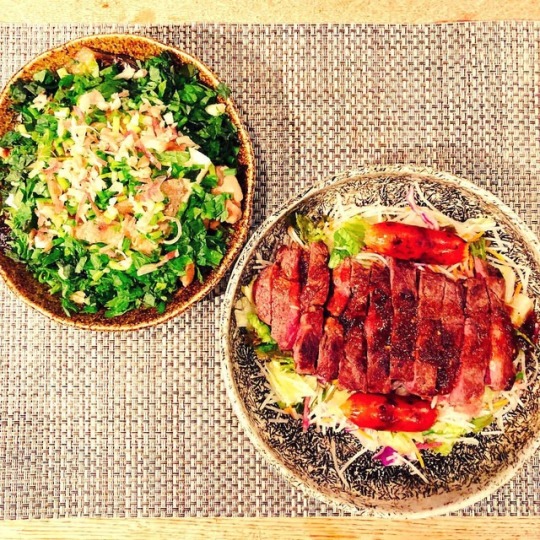
ロードバイク後のリカバリータンパク夕食は、ミスジのステーキと、特製木綿冷や奴。 冷や奴はナスと鶏肉をごま油で炒めて、そこに油揚げと鷹の爪を入れてめんつゆで煮て、大葉、ミョウガ、ネギをどどどーんと! #food #foodstagram #cooking #cookingram #iphoneX #foodie #yummy #foodporn #instafood #japanesefood #男飯 #protein #proteinfood #steak #豆腐 #豆腐料理
#foodporn#japanesefood#protein#foodie#instafood#豆腐料理#男飯#proteinfood#cooking#cookingram#豆腐#yummy#food#steak#iphonex#foodstagram
0 notes
Photo

✿ さば味噌バターの豆腐のせ
✍️ 味噌小2,めんつゆ小1,白ワイン大1,スパイス,いりごま
#cook:サバ缶#cook:さば缶#cook:白ワイン×味噌×めんつゆ#cook:いりごま#cook:木綿豆腐#cook:豆腐#cook:白ワイン×バター×味噌×めんつゆ#cook#cook:2020〜#2020〜#cook:魚#cook:魚:2020〜#cook:味噌
2 notes
·
View notes
Photo

. . 麻婆豆腐作りました . 材料:木綿豆腐 . 調味料:マボちゃん中辛、七味唐辛子 . ひじき、スープ、もち麦ご飯 . . . #男の料理 #おとこめし #料理男子 #弁当男子 #午餐 #ランチ #麻婆豆腐 #クッキングラム #ひとりごはん #ひとり暮らし #cooking #簡単レシピ #おうちごはん #インスタ萎え #日々 #手料理 #暮らし #料理写真 #私のおいしい写真 #おうちカフェ
#クッキングラム#ひとりごはん#ランチ#簡単レシピ#インスタ萎え#おうちカフェ#私のおいしい写真#料理男子#午餐#cooking#弁当男子#手料理#おとこめし#暮らし#料理写真#日々#おうちごはん#男の料理#ひとり暮らし#麻婆豆腐
0 notes
Photo
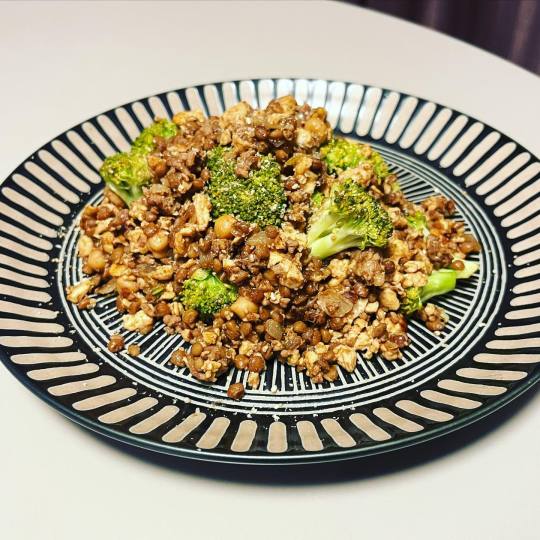
#ひき肉 #玉ねぎ #ガルバンゾー #ひよこ豆 #レンズ豆 #木綿豆腐 #ブロッコリー #カレー粉 #オイスターソース #すりごま * #まゆげごはん #MAYUGEgohan #おうちごはん #ふたりごはん #うちメシ #自炊 #男の料理 #料理男子 #男飯 #料理おじさん #food #instafood #foodstagram #cookingman #cooking #selfcook #EatAtHome #カマ飯 #gaycook https://instagr.am/p/CeOrJaJPDfO/
0 notes
Video
🌺#ちぇるちぇるらんど🌺の名物ごはん、今夜のおかずにどうです?🙌🏻💓 ***レシピ*** ■材料(4人分) ゴーヤ:1本 木綿豆腐:320g 塩:少々 サラダ油:小さじ2 スパム:160g サラダ油:小さじ2 だしa 水:大さじ2 和風だしのもと:小さじ1 卵:2個 醤油:小さじ1 白こしょう:少々 . ■作り方 1:下準備 ゴーヤは流水の下で、たわしでこすり洗いをし、水気を切る。 縦半分に切り、種とワタをしっかりと除き、幅2mmぐらいの薄切りにする。 木綿豆腐は、塩を少々ふり、ペーパーで包み、電子レンジ(500W)で3分加熱し、水気を除く。 スパムは幅1cmの短冊切りにする。 だしaは合わせておく。 2:炒める 鍋にサラダ油を熱し、豆腐を一口大にちぎり入れ、表面を焼き固め、焼き色をつけ、一旦取り出す。 油を足して、スパムを入れ、焼き色と香りがするまで中火で炒める。 ゴーヤを加え、ややしんなりするまで炒める。 3:鍋の中央をあけ、aを加え混ぜ、全体に絡める。 豆腐を戻し、崩さないように大きくひと混ぜし、卵を全体に回し入れ、さらに大きくひと混ぜする。醤油、コショウを加え、全体を混ぜたら完成! . ■レシピのポイント ゴーヤの扱い方 ゴーヤの苦味を和らげるためには、種の周りのワタをしっかりと取ること。 さらに苦味を和らげたい場合は、塩水に漬けるか、さっと下茹でをするという方法もある。 . ■アレンジ ゴーヤ以外では、青パパイヤ、ヘチマ、麩などで作ることができる。 スパムの代用は、塩、コショウで下味をつけた豚薄切り肉やベーコンを活用できる。 #ゴーヤチャンプルー#ゴーヤ#沖縄#🌺#夏#デリスタグラム#クッキングラム#今日の晩御飯#苦瓜#recipe#cooking #japanesefood #okinawa #ライフシアター
#ちぇるちぇるらんど🌺の名物ごはん#ゴーヤチャンプルー#クッキングラム#デリスタグラム#japanesefood#cooking#今日の晩御飯#沖縄#🌺#recipe#ライフシアター#okinawa#夏#ゴーヤ#苦瓜
0 notes
Photo

大人の炒め料理。おあがりよ。 【ししとうチャンプルー】 2人分 ししとう 15本程度 豚ばら肉 100g 木綿豆腐 150g 卵 1個 かつおぶし ひとつかみ 泡盛(酒) 大さじ1 塩、こしょう 適量 1.豆腐は水切りをする。ししとうはヘタを切り楊枝で穴をあける。豚肉は塩、こしょうでしっかり下味をつける。 2.フライパンに油を引き、豚肉を炒める。火が入ったら豆腐を、焦げ目がつきだしたらししとうを入れて炒める。 3.泡盛を回しかけ、溶き卵を回し絡める。塩をふって調整。火が入ったら、かつおぶしを和えて完成。 #おうち居酒屋 #ひとりごはん #おうちごはん #手作り料理 #晩ごはん #夜ご飯 #手料理 #夕飯 #自炊 #foodpic #dishes #cooking #japanesefood #foodgram #instacook #instadinner #foodstagram #instafood #料理好きな人と繋がりたい #クッキングラム #レシピ #簡単レシピ #家庭料理 #料理教室 #おうちカフェ #デリスタグラマー#ししとう #チャンプルー
#cooking#チャンプルー#おうち居酒屋#クッキングラム#簡単レシピ#夕飯#手料理#foodpic#instacook#自炊#ししとう#japanesefood#foodstagram#デリスタグラマー#おうちごはん#晩ごはん#instadinner#おうちカフェ#料理教室#dishes#instafood#レシピ#手作り料理#料理好きな人と繋がりたい#夜ご飯#家庭料理#foodgram#ひとりごはん
1 note
·
View note